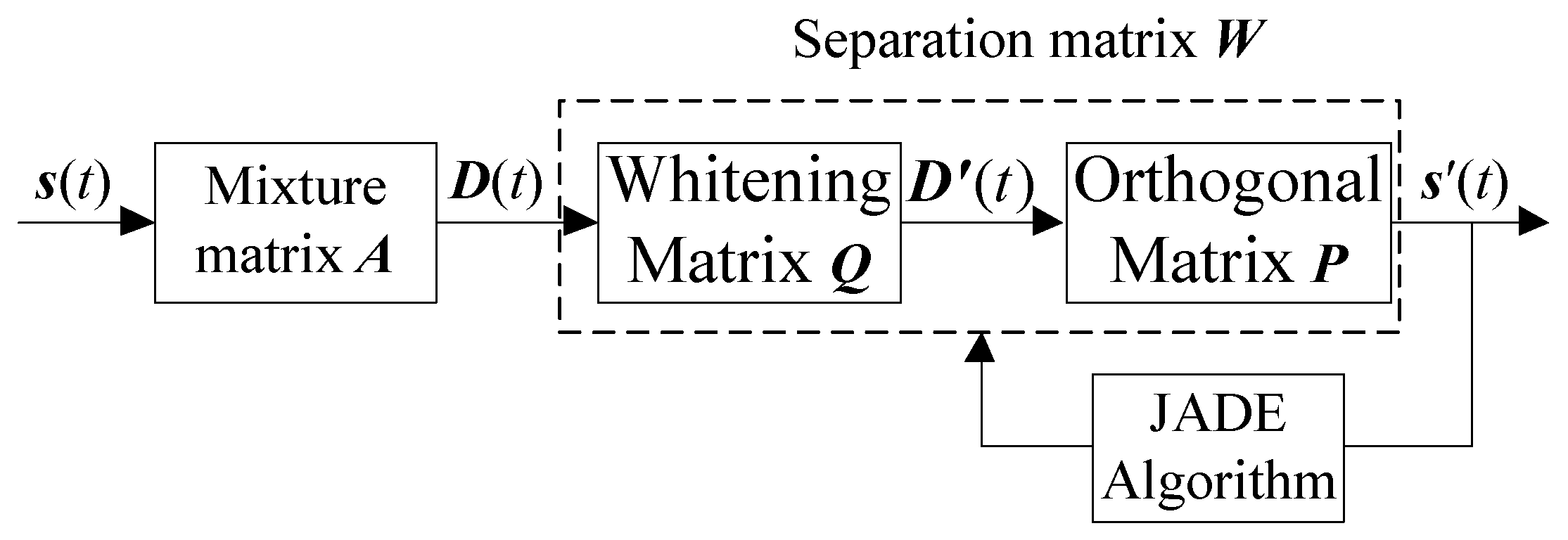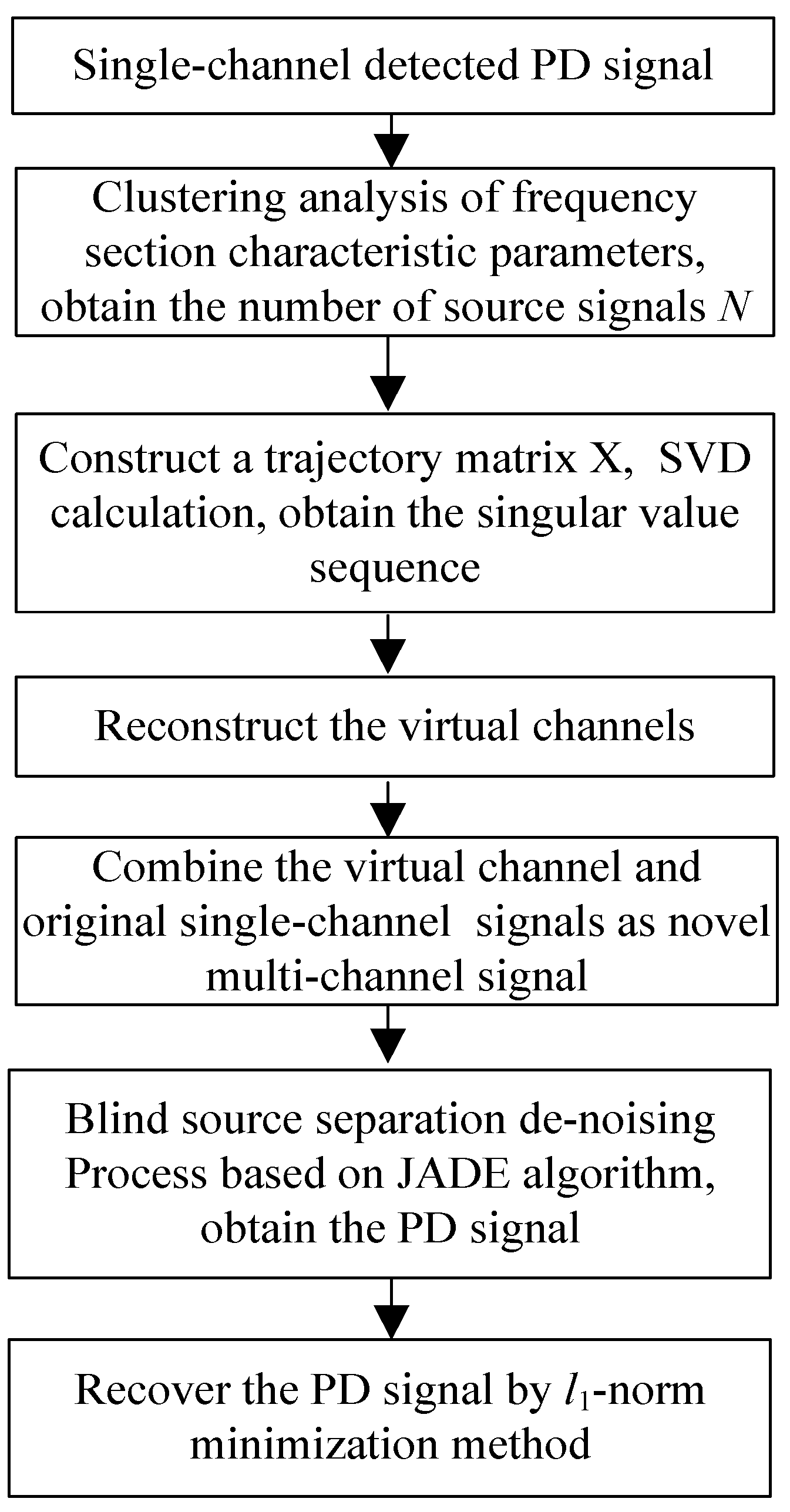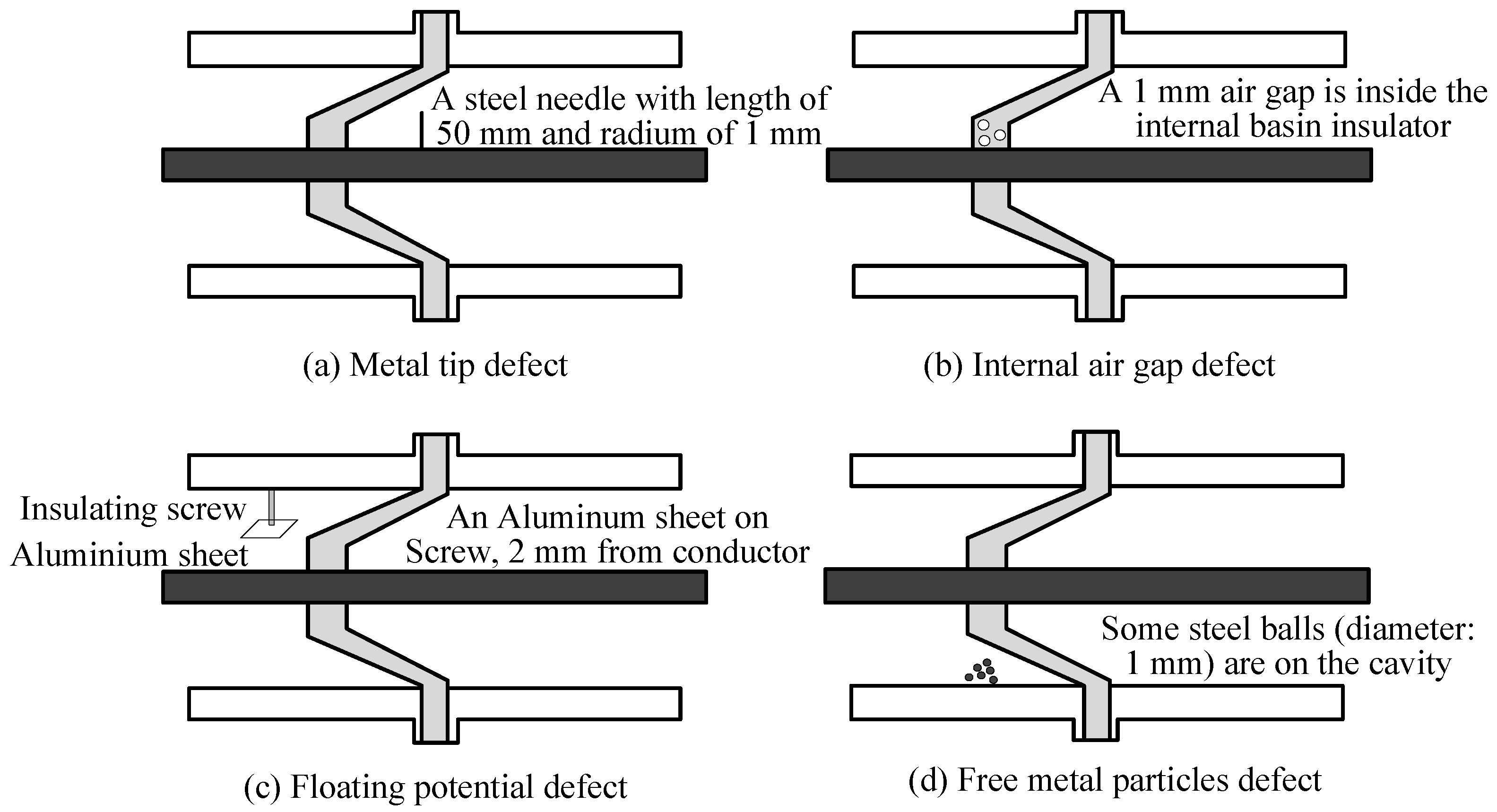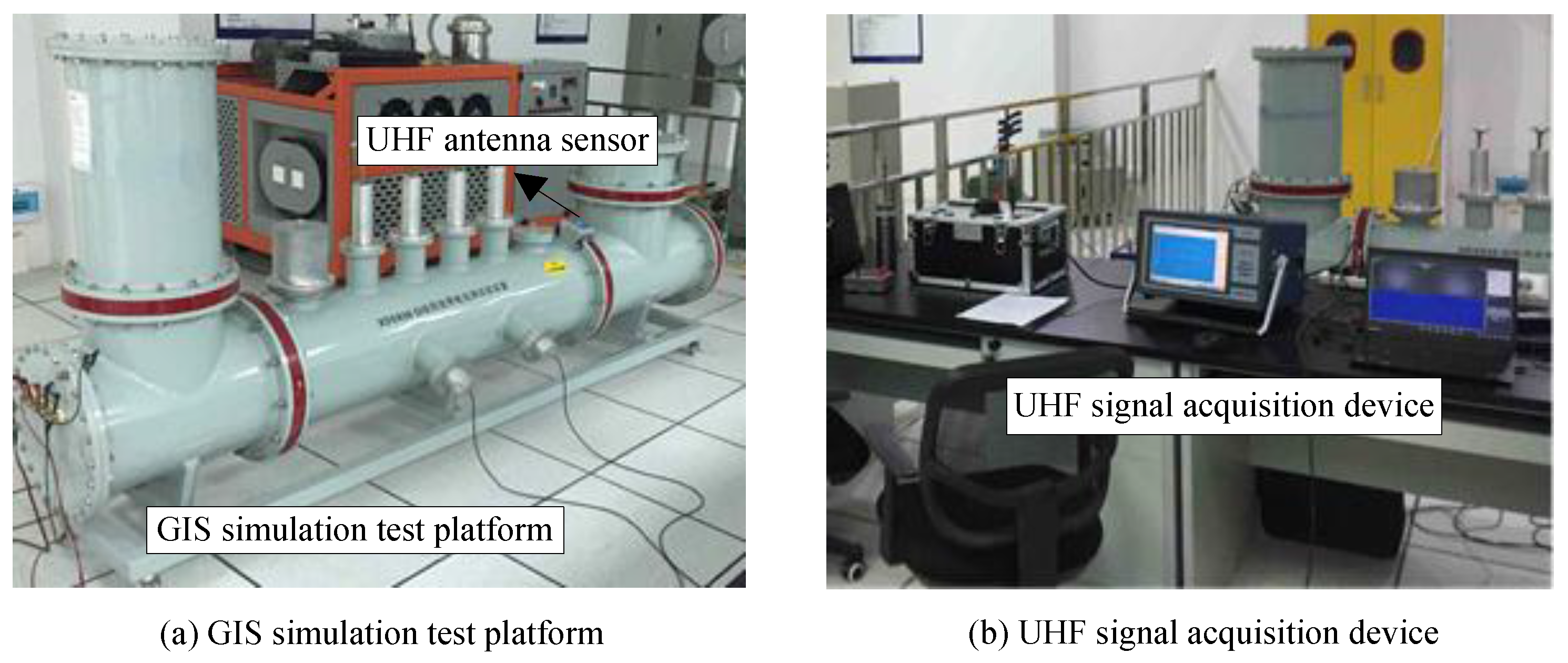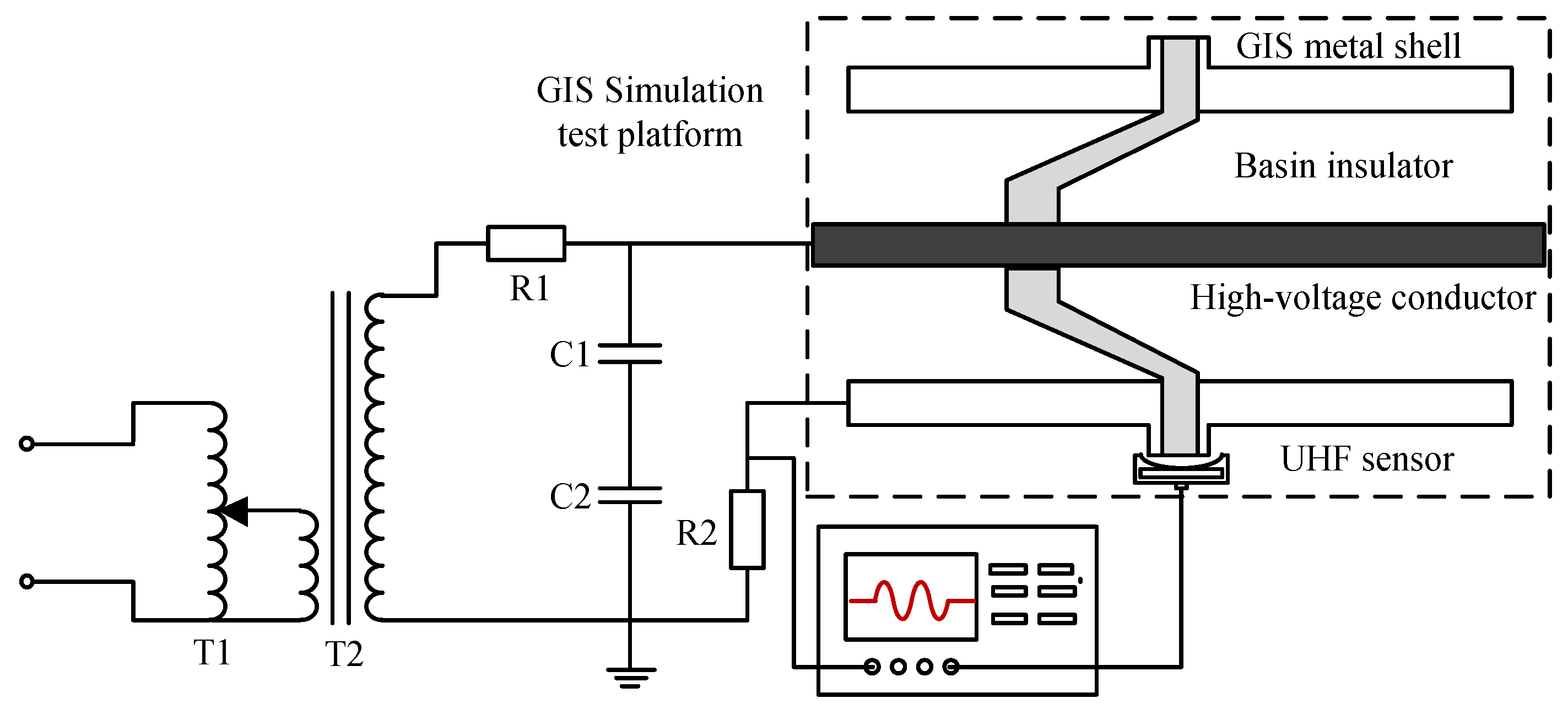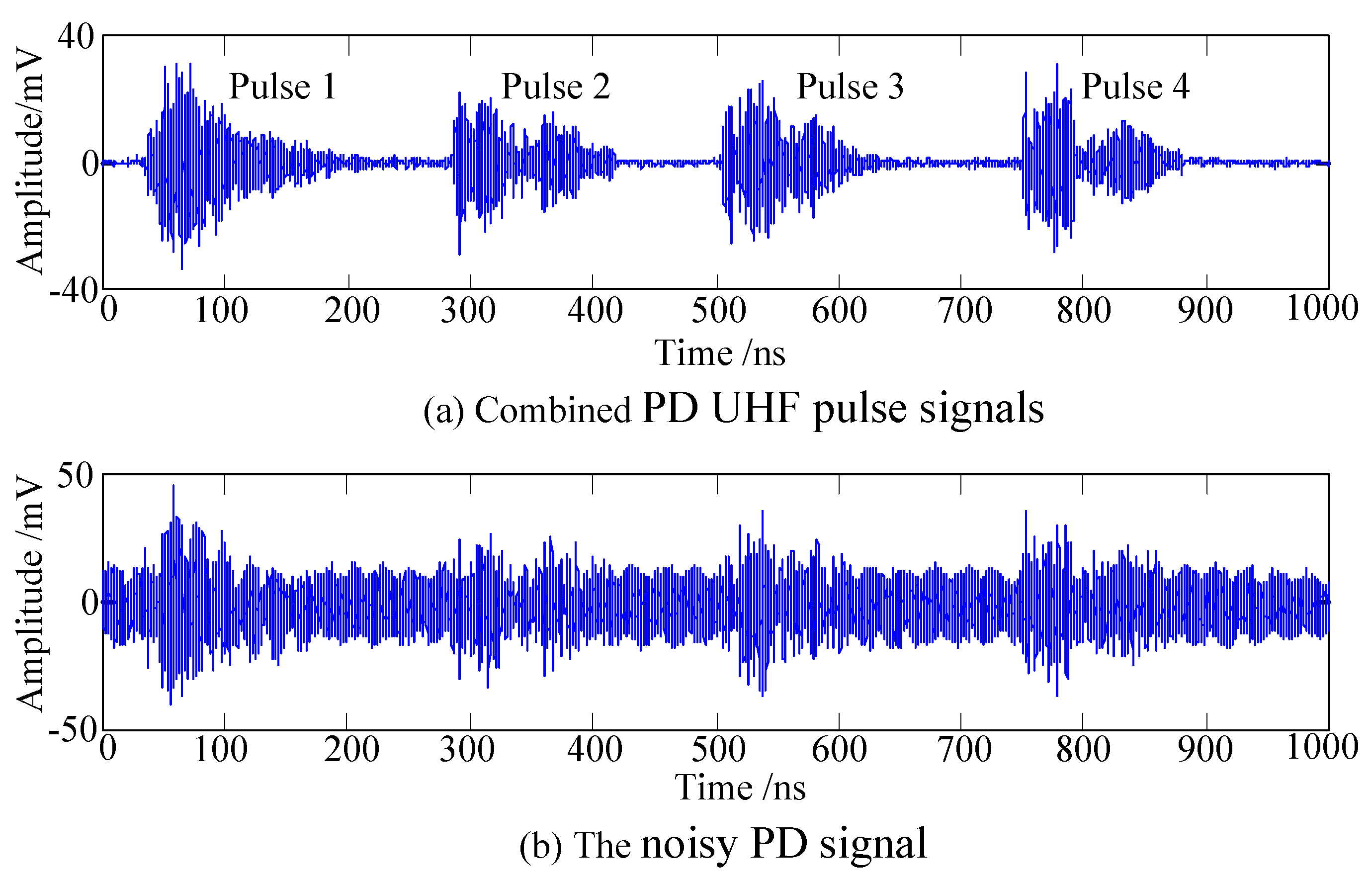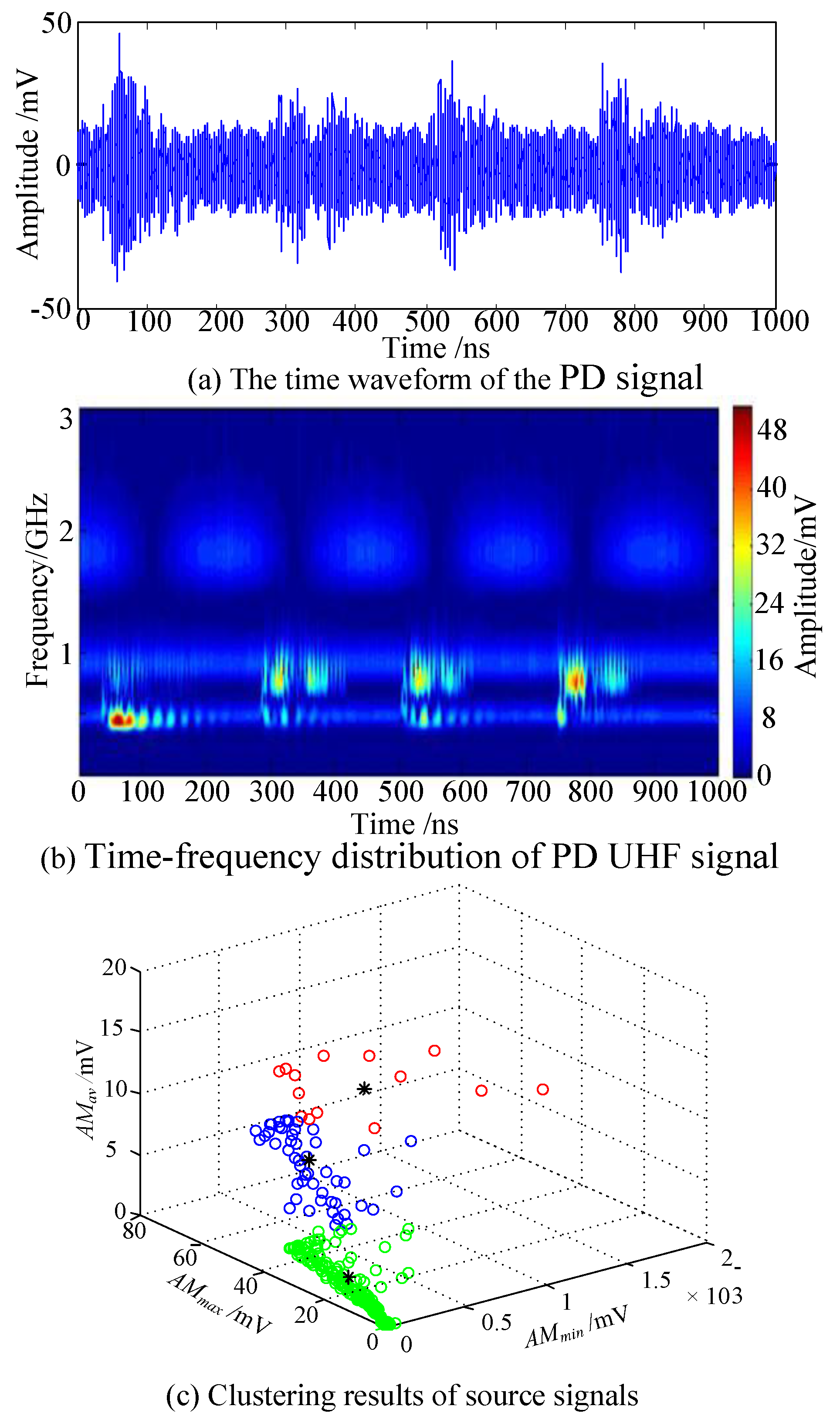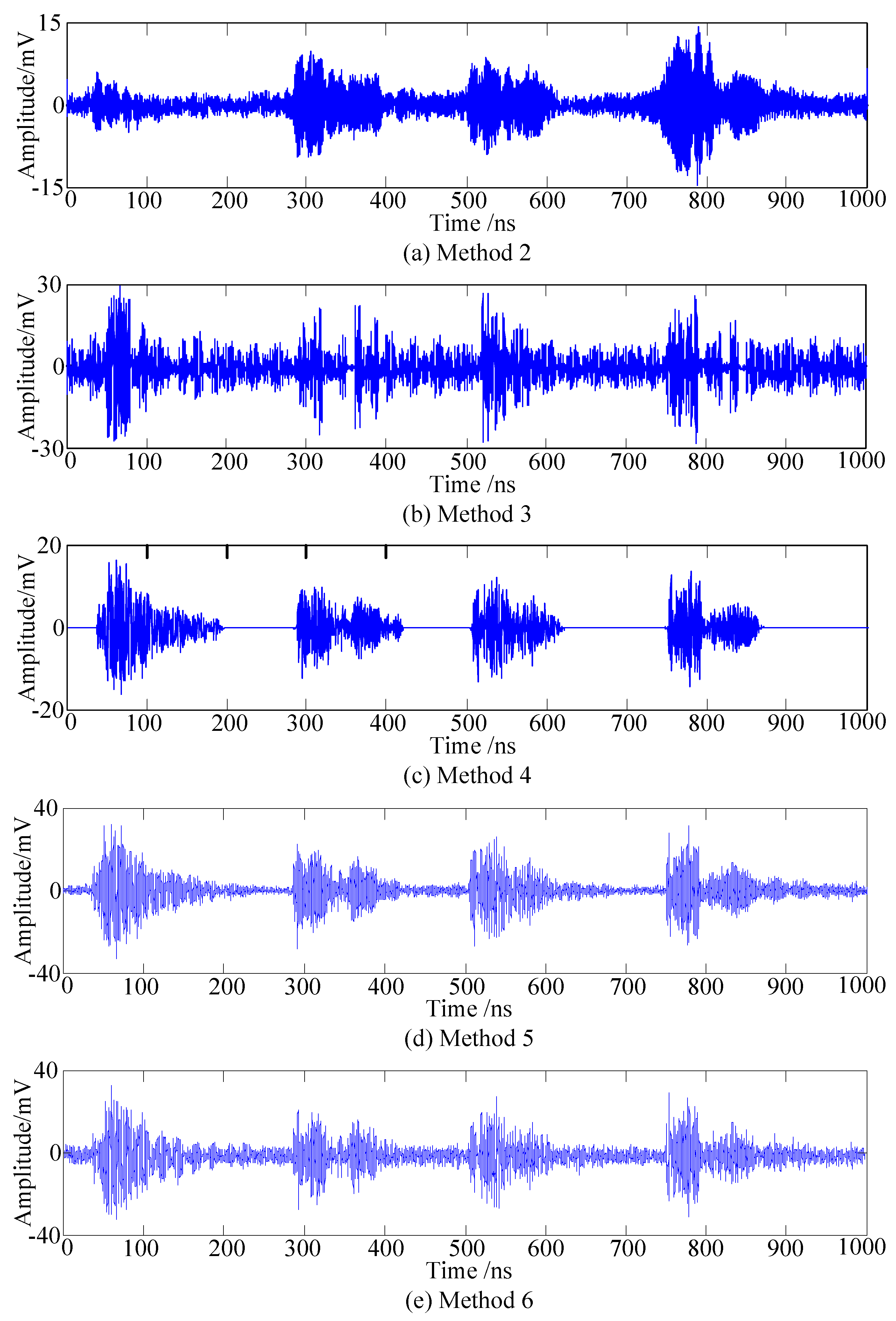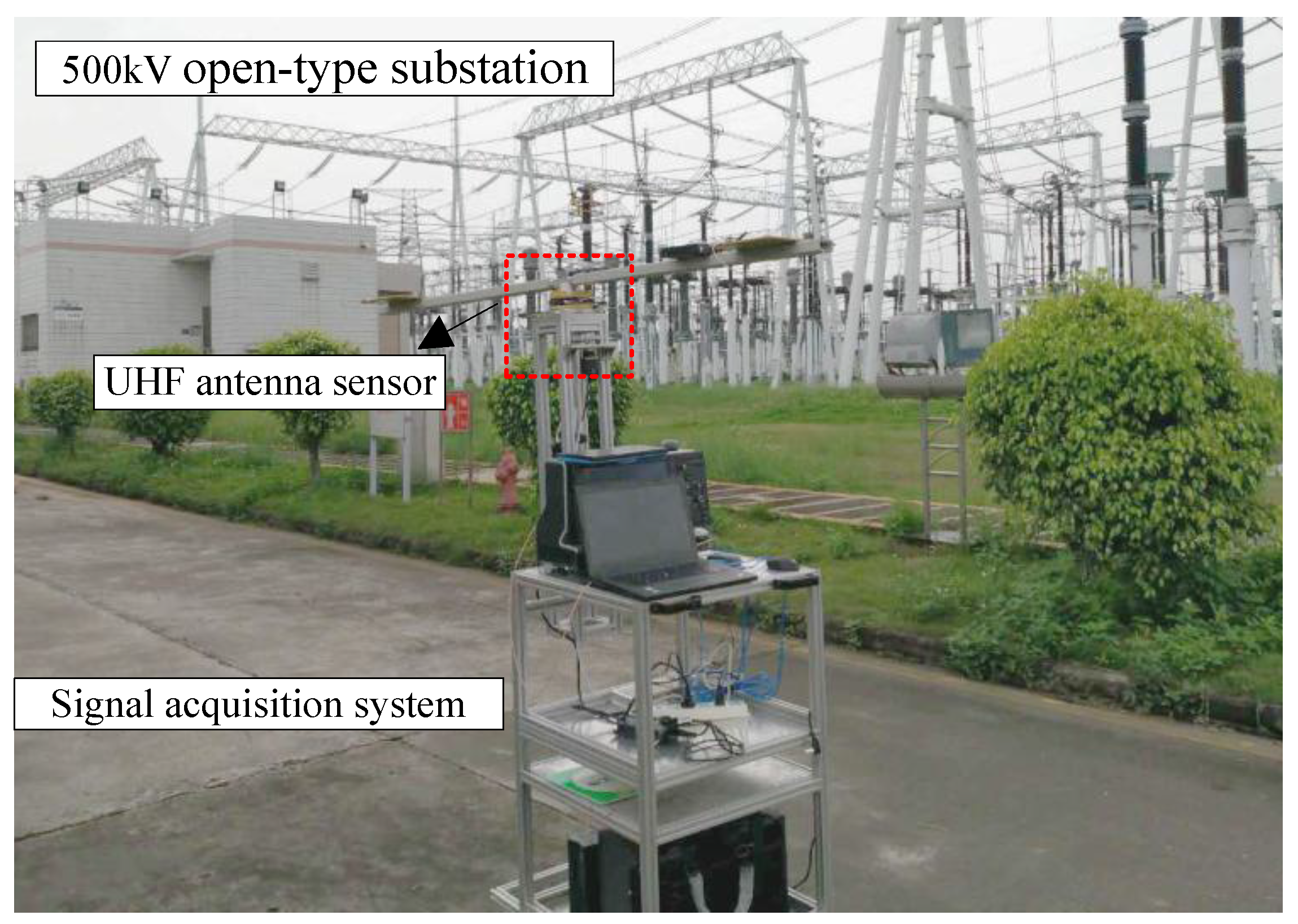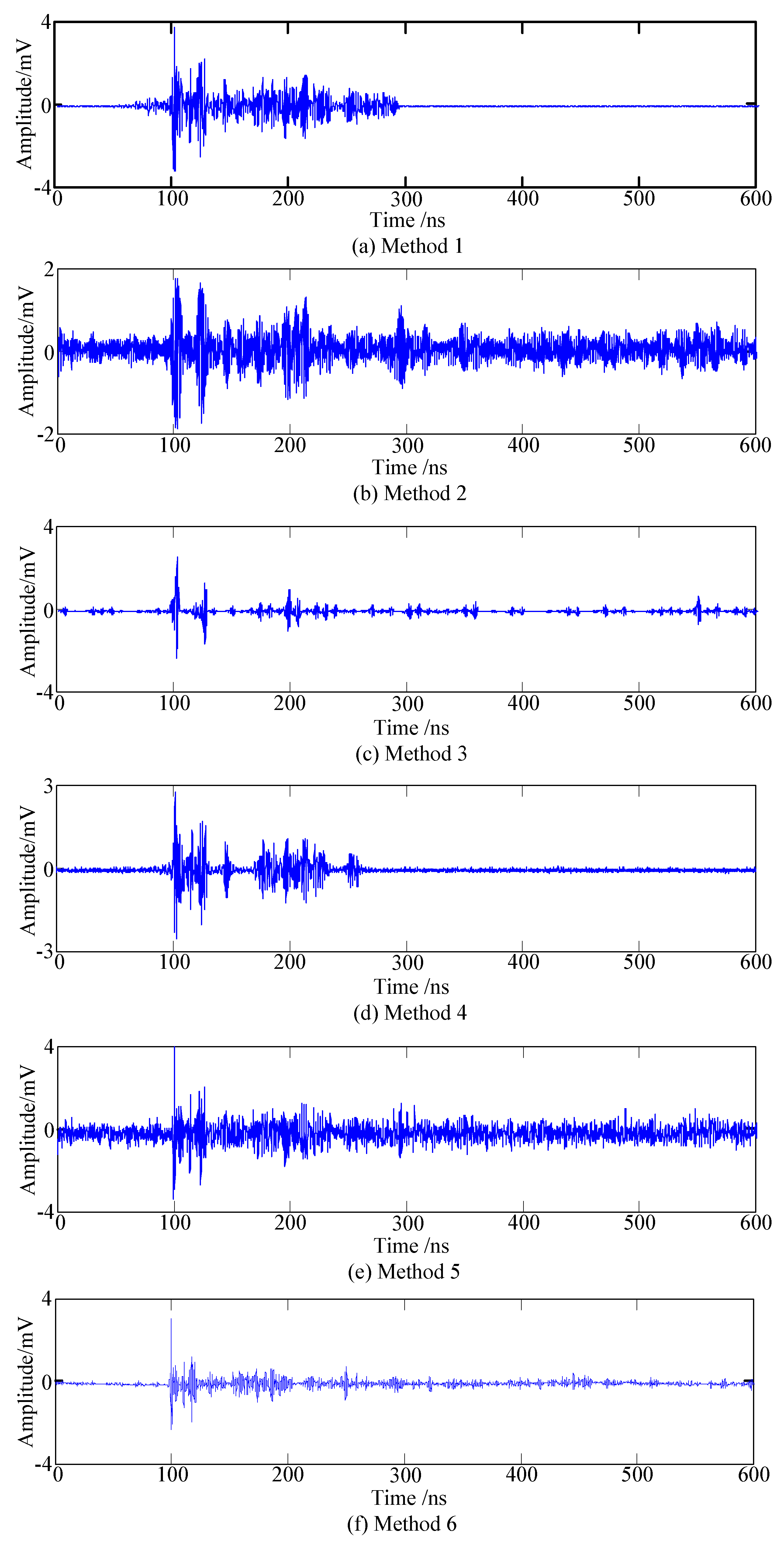1. Introduction
Partial discharge (PD), which is caused by insulation defects, can be utilized to evaluate the insulation state of high voltage devices [
1,
2,
3]. Since ultra-high frequency (UHF) signals (0.3–3 GHZ) will be also produced and propagated outside through the non-metal shielding dielectrics when PD occurs, the UHF antenna sensor can be used to detect the PD of high-voltage (HV) apparatus [
4]. However, since the PD UHF signal amplitudes are very low in the early insulation defects, and vulnerable to interference due to the numerous external electromagnetic waves, the detected PD signal will have serious waveform distortion, even submerged in background noise interference. Thus, the de-noising method has attracted extensive attention from researchers.
Periodic narrow-band interference and Gaussian white noise are the main components of background noise interference. Digital PD de-noising methods have been widely used, with the advantage of good noise suppression performance. There are several digital PD de-noising technologies, such as Fast Fourier transform (FFT) thresholding filtering, adaptive digital filtering (AF), empirical mode decomposition (EMD), undecimated Wavelet Transform (UWT), and adaptive wavelet thresholding (AWT) methods. Although FFT thresholding filtering and the AF method can effectively suppress the periodic narrow-band interference, the signal will be distorted when the frequency of PD signal and narrow-band interference are coincident [
5,
6]. The EMD method contains the modal aliasing problem which affects the de-noising performance [
7]. The UWT method is a commonly used wavelet de-noising method to suppress the noise interference [
8]. The AWT method can effectively suppress Gaussian white noise; however, since the wavelet basis and decomposed layers are difficult to select, the de-noising PD signal will be distorted when the wavelet transform method is used to suppress the periodic narrow-band interference [
9].
A chaotic oscillator method was proposed to effectively suppress the narrow-band interference signal [
10], but it cannot setup the system periodic frequency, and the calculation quantity is large. A reverse separation method, based on the independent component analysis (RS) method, was proposed to reversely separate the partial charge signal from the noise interference signals [
11], but the de-noising PD signal amplitude was changed. A sparse representation de-noising method was proposed in [
12], but it needs to establish the atomic library and takes a long time to complete the iteration calculation. A generalized S-transform module time-frequency matrix method (GSMT) was proposed for de-noising the PD signals in [
13], but it could not effectively suppress the amplitude modulated narrow-band interference during wireless communication, and large amounts of matrix operations were needed. To suppress the Gaussian white noise, a mathematical morphology filters (MMF) method was proposed to suppress the Gaussian white noise in [
14], and a novel singular value decomposition (SVD) method was proposed to suppress the Gaussian white noise and the original PD signal could be more accurately recovered in [
15].
Blind source separation technology (BSS) has been proposed to effectively separate the source signals when the characteristic parameters and models of source signals are unknown [
16,
17,
18]. All noise interference signals and original PD signals can be seen as the source signals, and the detected PD UHF signals are considered to be the observation signals. Hence, the original PD signal can be separated from the observation signals without solving the time-frequency information of narrow-band interference signals in the PD UHF signals.
This paper proposed a novel PD UHF de-noising method based on a single-channel blind source separation algorithm (BSS), which can effectively suppress the background noise interference of PD UHF signals and reduce the distortion of de-noising PD UHF signals. Firstly, the principle of de-noising method based on BSS is introduced in
Section 2. The single-channel signal can be converted into multi-channel signals by the singular value decomposition (SVD), and background noise is separated from multi-channel PD UHF signals by the joint approximate diagonalization of eigen-matrices, and the PD UHF signal from which the noise has been separated from can be recovered by estimation of the
l1-norm minimization method. The proposed method is applied in the simulation test and field test detected PD UHF signals in
Section 3 and
Section 4. In addition, the de-noising performances of different de-noising methods were evaluated and compared. The experimental results verify the effectiveness and correctness of the proposed method. In addition, conclusions are summarized in
Section 5.
2. Single-Channel Blind Source Separation De-Noising Algorithm
2.1. BSS Mathematical Model
Assume
s(
t) = [
s1(
t),
s2(
t), …,
sN(
t)] is the unknown independent vector from
N signal sources,
x(
t) = [
x1(
t),
x2(
t), …,
xM(
t)] is the known vector detected by
M sensors after several transmission process mixtures and
t is the time series. Since the superposition of the PD signal, periodic narrow-band interference signal and Gaussian white noise signal in the PD UHF signal is linear mixed, the mathematical model of linear mixed BSS can be expressed as [
19,
20].
where
A is the mixed matrix with
M in
N order.
Then, the unknown signal vector
s(
t) can be separated from the detected signal,
x(
t), by solving the separation matrix,
W. Assume
y(
t) = [
y1(
t),
y2(
t), …,
yN(
t)] is the output signal vector after BSS. The mathematical model of BSS is
where
W is the separation matrix with
N in
M order.
When M ≥ N, it is non-underdetermined blind source separation. The unknown PD signal vector s(t) can be directly solved by Equation (2). When M < N, it is underdetermined blind source separation. Since the solution of Equation (2) is not unique, the optimal estimate solution of s(t) can be only calculated by the estimation method. However, for PD UHF de-noising, a single sensor is always used to detect the PD UHF signal (M = 1), and the number of source signals (N) (includes the PD signal, white Gaussian noise signal and other narrow-band interference signals) will be larger than three (N ≥ 3), which is called single-channel BSS. Hence, the BSS based on matrix computation is not feasible. The one-dimensional signal vector, x(t), detected by single channel should be decomposed into multiple time-domain signals. The single-channel PD signals can be converted into multiple-channel signals, through establishing the virtual channels, meeting the requirements of non-underdetermined blind source separation.
2.2. Number Estimation of Source Signals
To establish the virtual channels, the number of source signals (N) is needed. Firstly, the one-dimensional time domain signal is mapped to a two-dimensional time-frequency domain through the time-frequency analysis of detected source signals. The amplitude–time source signals can be converted into amplitude–time–frequency signal. Hence, the number of source signals (N) can be obtained.
Due to the advantages of flexibility of time–frequency resolution and convenience, S-transform is used to convert the source signals. S-transform function can be expressed as [
21]
where
f represents the frequency,
t and
τ represent the time, and
g(
t −
τ,
f) represents the Gaussian window function.
Since the frequency distribution of periodic narrow-band interference is concentrated and the amplitude is large, a clustering analysis method of frequency section characteristic parameters, based on the time–frequency matrix of S-transform, is proposed to estimate the number of signal sources. The proposed clustering analysis method is as follows:
Step 1: Solve the time–frequency matrix based on S-transform, the frequency sections are extracted at each 10 MHz interval, such as 0~10 MHz, 10 MHz~20 MHz, etc.
Step 2: Compare the amplitudes of all time–frequency sampling points for each frequency section. The maximum amplitude (AMmax) is characteristic parameter 1, and the minimum amplitude (AMmin) is characteristic parameter 2.
Step 3: Solve the average amplitude (AMav) for all time–frequency sampling points for each frequency section as characteristic parameter 3.
Step 4: According to the characteristic parameters extracted in Step 2 and Step 3, the fast search and find of the density peaks clustering (FSFDPC) algorithm is proposed to cluster [
22]. The cluster number, which is the amount of periodic narrow-band interference (
Npn), can be obtained. The FSFDPC algorithm has better convergence capacities.
Step 5: According to the source signal statistical characteristics of blind source separation, the number of PD UHF signals and the Gaussian white noise signal are equal to 1. Hence, the number of the source signals is N = Npn + 2.
2.3. Multi-Channel Detected Signal Recombination
For single-channel BSS, the traditional method of constructing virtual channels is the empirical mode decomposition (EMD), which can decompose the single-channel signal into intrinsic mode function signals. However, since the PD UHF signal and periodic narrow-band interference source signal are independent, the traditional method has the modal aliasing problem which will negatively affect the final signal separation result. Therefore, this paper proposed a novel multi-channel detected signal recombination method based on SVD. The trajectory matrix (
X) of detection signal
x(
t) can be expressed as [
23,
24]
where
X is the trajectory matrix,
U and
V are the orthogonal matrices with
m by
n order, respectively,
Λa = diag (
a1,
a2, …,
an) is a diagonal matrix,
a1,
a2,
…,
an are the singular values of mixed matrix
A.
Since matrix
A with rank
k can be expressed as the sum of
k submatrices with rank 1,
where
ui and
vi are the singular value vectors of the
i-th column of matrices
U and
V, respectively.
Xi is a submatrix.
Each submatrix in SVD is multiplied by the singular value weight and two eigenvectors are derived from matrices U and V, respectively. The submatrix and the singular value (ai) have a positive correlation. Hence, since the time–frequency distribution of the PD signal and periodic interference is relatively concentrated, the amount of information of the singular values is large. When the time–frequency distribution of Gaussian white noise signal is dispersed, the amount of information of the singular values is smaller. In addition, the submatrices for different singular values (ai) are statistically independent, the corresponding submatrices with the first N singular values can be obtained through the SVD calculation of the single-channel detection signal, x(t). Then, the virtual channels are constructed by signal reconstruction calculation, and the multi-channel signals can be recombined for blind source separation de-noising.
Hence, the proposed multi-channel detected signal recombination method is as follows:
Step 1: Construct a trajectory matrix (
X) of signal
x(
t), as follows:
Step 2: The SVD calculation for trajectory matrix X, and the singular value sequence a1, a2, …, aN is obtained.
Step 3: Extract the first
N singular value sequence (
a1,
a2, …,
aN) and the corresponding submatrices. Reconstruct the virtual channels.
where
Cj is the virtual channel signal trajectory matrix.
Λj = diag ((0, …, 0),
aN, (0, …, 0)),
j = 1, 2, …,
N.
Step 4: Inversely calculate the trajectory matrix (Cj), according to Step 1. The virtual channel signal, Cj(t), can be obtained.
Step 5: Recombine the virtual channel signal, Cj(t), and the original single-channel detected signal, x(t), as the novel multi-channel detected signal, D(t) = [x(t), C1(t), C2(t), …, CN(t)]. It will become the non-underdetermined blind source separation.
2.4. BSS De-Noising Method Based on the JADE Algorithm
The separation matrix (
W) is the most important for BSS. This paper proposed the JADE algorithm to solve the separation matrix,
W. The JADE algorithm introduces a fourth-order cumulant of multivariate data to estimate separation matrix
W by characteristics decomposition and joint approximation diagonalization [
25]. The blind source separation de-noising method based on the JADE algorithm can be divided into two steps to solve the separation matrix (
W) whitening process and orthogonal transform processes, as shown in
Figure 1.
Firstly, the multi-channel detected signal,
D(
t), should be whitening processed to eliminate the second-order correlation between the components. The whitening process can be expressed as [
25]
where
Q is the whitening matrix,
D′(
t) is the signal after the whitening process, in which each component is relatively independent and the variance is 1, and matrix
C is the product of matrices
Q and
A.
Assume
Rx is the correlation matrix of the multi-channel detection signal
D(
t), and
D(
t) can be eigenvalue decomposed as
where matrix
is the orthogonal matrix, in which the diagonal elements are the eigenvalues of matrix
Rx, and the corresponding standard orthonormal eigenvector is the column vector of characteristic matrix
E.
The whitening matrix (
Q) can be expressed as
Since the component variances of
s(
t) and
D′(
t) are both 1, each element of
s(
t) is independent, and each element of
D(
t) is orthogonal; matrix
C is an orthogonal normalized matrix and can be expressed as
where
IN is the
N-order unit matrix.
The matrix,
D′(
t), after the whitening process needs the orthogonal transformation to make aure that the components after blind source separation are not correlated and the variance is 1. The orthogonal transformation process can be expressed as
where matrix
P is the orthogonal matrix,
s′(
t) is the approximate
s(
t) by orthogonal transformation estimation.
The fourth-order cumulant of
D′(
t) is
where 1 <
i,
j,
h,
l <
L,
kp is the fourth-order cumulant of each element and
cip,
cjp,
chp,
clp are the elements of (
i,
p), (
j,
p), (
h,
p), (
l,
p) of matrix
C, respectively.
For any matrix (
M) with
L by
L order, the fourth-order cumulant matrix,
QD(
M), can be expressed as
where
mhl is the element (
h,
l) of matrix
M.
According to Equation (9), Equation (14) is
where
QS(
M) is the fourth-order cumulant matrix of
s(
t).
Since the components of
s(
t) are statistically independent, matrix
QS(
M) is the diagonal matrix. Select a matrix,
M = [
M1,
M2, …,
Mr], the orthogonal matrix (
P) can be solved by joint approximate diagonalization of matrix
QD(
M). The quadratic sum of diagonal elements is defined as the evaluation index of the joint approximate diagonalization calculation,
The orthogonal matrix P can be solved by minimizing E(P). Then, the whitening matrix (Q) and the separation matrix (W = QP) can be obtained.
2.5. PD Signal Recovery After De-Noising
Since the signal,
s′(
t), after blind source separation, based on the JADE algorithm, is an approximate signal vector of
s(
t), the amplitude of
s′(
t) is different from the source signal. To improve the accuracy of blind source separation, this paper proposed an
l1-norm minimization method to recover the original approximate PD UHF signal,
s′(
t). For a matrix with
M′ by
N′ order,
solutions can be obtained in the
l1-norm minimization [
26]. Hence, the minimum norm solution can be obtained through comparison with the solutions. The
l1-norm minimization method is shown as follows:
Step 1: Calculate the submatrices with M′ by N′ order of mixture matrix A, which is denoted as Bg = [Bg1, Bg2, …, BgM′], g = 1, 2, …, ; g1, …, gM′ ∈ {1, …, N′}.
Step 2: Solve the minimum
l1-norm solution at
t =
t0. The solution can be expressed as
Step 3: Calculate the
l1-norm
Jg of solution
s′
(g)(
t0), as follows
Step 4: Calculate the minimum norm as the approximate signal
s′(
t0) at
t =
t0 as follows
Step 5: Calculate s′(t) at all time points, reconstruct the PD source signal, and the signal recovery of PD signal is complete.
The proposed flow chart for the proposed PD UHF signal de-noising method based on single-channel blind source separation is shown in
Figure 2. Firstly, the single-channel detected signal is analyzed through time–frequency analysis by S-transform, the frequency section characteristic parameters based on the time–frequency matrix of S-transform is used for clustering analysis, and the number of source signals (
N) can be obtained. Then, construct the trajectory matrix of the detected signal, and the singular value sequence of the corresponding submatrices can be obtained by SVD calculation. The virtual channel can be reconstructed, and novel multi-channel signals can be obtained by combining the virtual channel and original single-channel signals. In addition, the PD signal can be separated from the mixed signals by BSS based on the JADE algorithm. Finally, the PD signal can be recovered by the
l1-norm minimization method.
4. Field Test for De-Noising
The live PD detection was performed on a 500 kV open-type substation in operation, as shown in
Figure 11. The devices are the same as those for the simulation test in
Section 3.
Figure 12 shows the detected PD UHF signal with noise interference. The PD signal is seriously interfered by the background noise and has obvious distortion. Six methods in
Table 2 were performed to de-noise the detected PD UHF signal in the field test. The de-noising results are shown in
Figure 13.
Since the original PD UHF signal with no noise interference cannot be obtained in the field test, the evaluation method in
Section 3.2 cannot be used to evaluate the de-noising performance. Hence, the evaluation indices of the noise suppression ratio and the amplitude attenuation ratio are proposed for evaluating the de-noising performance in the field test. The noise suppression ratio denotes the suppression effect of the PD UHF signal after de-noising. The de-noising effect is positively proportional to the noise suppression ratio. The amplitude attenuation ratio denotes the attenuation degree of the PD UHF signal after de-noising. The distortion degree is positively proportional to the amplitude attenuation ratio.
Table 4 shows the evaluation results of de-noising performance for various methods. The proposed de-nosing method can effectively suppress noise interference, and the amplitude attenuation of the de-noising PD signal is the smallest, compared with traditional methods. In addition, the proposed method can effectively reduce the calculation amount and computing time.
5. Conclusions
This paper proposed a novel PD UHF signal de-noising method, based on a single-channel blind source separation algorithm. This method utilizes the SVD calculation to convert the single-channel detected PD signals into multi-channel detected signals, and can effectively suppress the background noise in the PD UHF signals, combined with the JADE and l1-norm minimization methods. The conclusions are as follows:
- (1)
The submatrix of the SVD decomposition of the original PD signal can convert the single-channel detected PD signal into multi-channel PD signals; the underdetermined problem of blind source separation can be effectively solved.
- (2)
The l1-norm minimization method can effectively solve the large amplitude vibration problem after single-channel blind source separation, which is better for the subsequent signal processing and analysis.
- (3)
Compared with traditional methods, the proposed method can effectively de-noise the Gaussian white noise and periodic narrow-band interference, and have small distortion.
The proposed method can be applied in the field partial discharge location and the insulation defect identification of HV apparatus. In addition, the field partial discharge location based on the proposed method will be studied in the future work.
